On a clear night in the spring of 2017, Rob Ponte found himself in the middle of a forest in Massachusetts, chained at his wrists and ankles. He’d just spent hours in the back of a windowless van with three other men, and now he could see a construction trailer illuminated by bright orange floodlights and, in the distance, a clearing with a complex of cinder block buildings. Ponte, then a 30-year-old with a wan face and an athletic build left over from years of playing ice hockey, was taken by uniformed guards and brought into the trailer. He and the other men were told to strip. One by one, they were searched, photographed, and handed orange jumpsuits emblazoned with “D.O.C.” across the back. One of the guards ran through a list of questions: “Are you a member of a gang? Have you ever been incarcerated before?” It was then that Ponte realized he was being locked up.
But Ponte had not been charged with a crime. He was there because his father, who’d recently watched him relapse after years of wrestling with addiction, had asked a judge to have him civilly committed—essentially, forced into rehab.
Civil commitment allows states to confine people like Ponte who have not been convicted—or even accused—of a crime, if a judge decides they pose an imminent danger to themselves or others. Civil commitment laws have historically applied to people with mental illness, but recently they’ve been deployed to round up victims of the opioid epidemic. Thirty-seven states now allow court-ordered treatment for opiate or other substance addiction. While many commit fewer than 500 people each year, Massachusetts—which has one of the highest rates of overdose in the country, as well as universal health care that pays for a certain amount of rehabilitation—has been particularly aggressive in applying its civil commitment law, known as Section 35. Between 2010 and 2016, Massachusetts saw an 83 percent increase in the number of Section 35 commitments. Ponte was one of about 6,500 people “sectioned” there for substance use last year.
Many families in Massachusetts consider civil commitment a lifeline. What they don’t often know, however, is that their loved ones might be sent not to a hospital or rehab facility, but to the Massachusetts Alcohol and Substance Abuse Center (MASAC), a prison turned treatment center in Plymouth run by the Department of Corrections. Surrounded by a barbed wire fence and secured by more than 100 correctional officers, MASAC can house 251 patients, who are issued “inmate” ID cards. (The Department of Public Health funds the state’s only other Section 35 treatment facility for men; it has fewer than 110 beds.)
Massachusetts is the only state that explicitly allows men who are civilly committed to be housed in prisons—in 2015, a lawsuit by the American Civil Liberties Union and other advocacy groups ended the practice for women—but similar policies have come under scrutiny in other states. In Florida, which commits more than 9,000 people per year for substance use disorders, at least six lawsuits have been filed by plaintiffs who claim they were wrongly jailed under the state’s civil commitment law. And across the country, even those who aren’t held behind bars are likely to face problematic conditions; some addiction specialists say patients who are civilly committed have been forced by judges with no medical training into facilities that do not provide adequate care, leaving them extremely vulnerable to overdose once they are released.
When the booking procedure was over, Ponte and the others were brought to a large room with glass observation windows and two rows of cots to begin detoxing. From his previous stints in rehab, Ponte expected to get medication to cope with withdrawal—for an opiate addiction, specialists say tapering down the dose over five to seven days is the shortest period that’s humane—but he and the others were only given clonidine, a blood pressure medication. “They laughed at me when I told them I needed the detox protocol,” Ponte told me. “I was thinking about climbing out the window or doing something crazy. I didn’t have the strength to, but I was desperate.”
Detox symptoms, including nausea, dehydration, and intense stomach pain, can be dangerous and even life-threatening if untreated. At night, Ponte told me, men who were too sick to sleep would gather by the sinks in the bathroom to talk. Once, Ponte said he saw a guard step over an unconscious patient and continue with the count. “Nobody would even check him out,” he said.

Rob Ponte, 31, at his father’s home in Littleton, Massachusetts, in February 2018.
Tristan Spinski
Under Section 35, Ponte was entitled to receive at least 20 hours of therapy a week, but during his time at MASAC, he only saw a single caseworker making rounds. Group therapy classes were held twice a day in hot, windowless sheds; often the counselors played DVDs from Alcoholics Anonymous or movies like Dallas Buyers Club. One man told his lawyer that his class watched Flight, in which Denzel Washington plays an addicted pilot, two days in a row.
Meanwhile, Ponte says he faced intimidation and insults from guards, who were not used to seeing themselves as caretakers. Other inmates told me that guards routinely mocked them for their addictions and ignored their requests for medical care. (The Department of Corrections denied many of Ponte’s allegations.) “Rehab is supposed to be about boosting people’s self-esteem,” one patient told me, “not destroying it.”
“It’s traumatizing to be strip-searched and shoved into a cell,” Ponte said. “Some of the guys, they’d never even had a speeding ticket; they just had a drug problem.”
Civil commitment statutes arose out of a 1962 Supreme Court ruling that overturned the sentence of Lawrence Robinson, a young Army recruit who was convicted of “being an addict” and sentenced to jail for 90 days. The court ruled that prosecuting a person for drug addiction—an illness—violated the Eighth Amendment. “Even one day in prison,” Justice Potter Stewart wrote in the opinion, “would be a cruel and unusual punishment for the ‘crime’ of having a common cold.” But, Stewart added, while states could not criminalize substance abuse, they could force drug users into treatment programs that might “require periods of involuntary commitment.”
Section 35, which Massachusetts enacted in 1970, allows a family member, law enforcement officer, or medical professional to petition a judge to have someone committed for up to 90 days. Defendants are entitled to legal representation, but the presence of a lawyer is often a formality. Kellie Sanders, a former public defender in Plymouth, told me she typically spent less than 10 minutes with her client before a hearing; 95 of the last 100 people she represented were committed to treatment.
Some of the most vocal advocates for civil commitment are the families of people who have overdosed. In 2002, after a 23-year-old named Casey Wethington died of a heroin overdose in Kentucky, his mother, Charlotte, began campaigning for involuntary treatment. “The only hope that many of addicted individuals have,” she wrote on her blog around that time, “is that someone will do for them what they are incapable of doing for themselves.” Kentucky passed Casey’s Law in 2004, and Charlotte Wethington went on to lead similar efforts in Ohio and Indiana.
The popularity of civil commitment among these families is the reason MASAC still exists. In 2009, when the Department of Corrections faced large budget cuts and attempted to close the facility, dozens of mothers organized a protest outside the Statehouse. They wore handcuffs and carried signs saying, “Our kids will die without MASAC.” Joanne Peterson, the director of Learn to Cope, an addiction support group, placed op-eds in several local papers. “If MASAC closes,” she said, “every obituary will be sent to the governor and the commissioner. There will be lawsuits ahead when people start dying.” The governor decided to keep the facility open, and it has since expanded from 150 to 251 beds.
But forcing family members into treatment may be a mistake. “The science doesn’t support involuntary commitment when the potential negative ramifications are so high,” Sarah Wakeman, the medical director of the Substance Use Disorders Initiative at Massachusetts General Hospital, told me. While only a handful of studies have looked at the success rates of such programs, the results have been mixed. One 2016 study in Massachusetts found that people who have been civilly committed went on to overdose twice as often as people who had undergone treatment voluntarily. (Advocates of civil commitment are quick to point out that it is impossible to know how many of them would have overdosed and died if they had not been committed.)

Rob Ponte and his father, Frank Ponte
Tristan Spinski
Not only are people forced into treatment likely to remain resistant to it, but most civil commitment facilities do not provide evidence-based care. They typically draw from the 12-step model used by Narcotics Anonymous, which encourages abstinence through counseling. Many addiction specialists, though, say abstinence-based programs aren’t effective—and can, paradoxically, be dangerous, because patients whose tolerance has been lowered by a few days of detox are at a heightened risk of overdose if they return to using. Decades of research show that a combination of psychotherapy and addiction medications like methadone or buprenorphine (themselves opioids) is the most effective approach. The health department’s facility in Massachusetts provides this medication, but MASAC does not. The Department of Corrections says it does not want to introduce drugs into a drug-free environment. Even though it can hold people for up to 90 days, its goal, says spokesman Chris Fallon, is simply to provide a clean facility in which people can detox.
Rather than investing in civil commitment, Wakeman argues, states should focus on lowering the barriers to treatment for those who want it. “The status of the current treatment system is so underequipped to deal with this problem that parents would rather have their children go to jail than die,” Wakeman said. “Anyone given those choices would choose to have them in jail against their will. But it’s a false choice. Simply being removed from your environment and detoxed off your drug is not treatment.”
After 48 hours at MASAC, Ponte complained to guards about the lack of food and medical attention, but they ignored him. So later that day, he and 50 other men staged a protest in the yard. When the guards told them to return to their cells, they refused. Finally a sergeant agreed to take their requests to the superintendent, and the inmates dispersed. That night, though, guards burst into Ponte’s room while he was sleeping. They strip-searched him and put him in a van heading to a nearby medium-security prison for sex offenders called the Massachusetts Treatment Center.
There, Ponte was held in solitary confinement for as long as 24 hours a day. He had no clothing except for a green suicide smock; the overhead lights were always on. After about a week, he started calling down the row and asking who around him had also been at MASAC. Next door was a young Marine who’d earned a Purple Heart in Iraq and started using drugs when he was prescribed opioids after a car crash. In addition to the Marine, Ponte determined that others who had organized the protest were there, as well as several men who had tried to run away from MASAC.
In June, some three weeks after Ponte was first sectioned, his father, Frank, got a call from a lawyer at Prisoners’ Legal Services. Conditions at the medium-security facility were bleak, she told him. Some general-population inmates were angry that the Section 35s were occupying single-man cells while they double-bunked, and they were threatening the men and their families. Three of the Section 35s had attempted suicide: one by hanging, two more by cutting their wrists. The lawyer told Frank that she planned to file an injunction alleging that the men’s solitary confinement violated their constitutional rights. In late July, after a court hearing, the Department of Corrections agreed to move Rob Ponte and the other Section 35s, who by then had been confined in the medium-security prison for two months, back to MASAC for the remainder of their commitment. Ponte stayed there for another two weeks, having been sectioned for a total of 75 days.
When I visited Rob and Frank Ponte in November, Rob had been out for three months. He was living at a sober home in Worcester, where the landlord kept a dose of Narcan, a medication to reverse the effects of overdose, tacked to the wall in each apartment. Rob suspected that people there got high, recalling one man who started using again after his girlfriend died from an overdose. Still, Rob said he wasn’t tempted; he was going to counseling and hoped to move out soon. A friend at the house had found him a job on a landscaping crew. “I’m pulling mulch out of my ears by the time I get home,” he told me.
Frank was the more comfortable and talkative of the two. He fell into clichés when discussing his son—a “good kid” with a “big heart” who had fallen in with the “wrong crowd”—as though using them would bring about a return to normalcy. I asked Frank whether Rob’s experience had caused him to reconsider his support for civil commitment. He said no. “The ability to section someone and expect that they’re going to be taken to a secure facility and treated isn’t unreasonable,” he explained. “Then again, as a parent, you want them to receive the treatment they deserve, not just get locked up and treated as cruelly and inhumanely as they were.”

Meanwhile, problems have persisted at MASAC. Late last year, one man was beaten almost to death by another patient; another was raped by his roommate. According to Jim Pingeon, a Prisoners’ Legal Services lawyer, guards at MASAC routinely verbally harass and sometimes physically assault patients. “Patients who act up in any way are placed in segregation cells that have no toilets,” he wrote to me. “Several patients have described having to urinate or defecate on the floor.” In late September, a 29-year-old man named David McKinley hanged himself in his cell, which prompted the Plymouth County district attorney to open an investigation into the incident.
Despite the controversy, Gov. Charlie Baker granted the facility an additional $3 million in his 2019 budget. Even though people will no longer experience quite what Rob did—as part of an agreement with Prisoners’ Legal Services, the Department of Corrections has pledged not to house Section 35s for long periods of time in the medium-security prison—the department reserves the right to place patients there for up to two days if they require heightened security.
Earlier this year, Rob relapsed. Drugs were being sold out of a building down the block from his sober house, and he told me that one day “someone offered me something, and I just didn’t say no.” At a February pretrial hearing for an old theft charge, he told the judge that he was no longer sober but had already made an appointment to start Suboxone treatment and therapy. Nevertheless, his lawyer recommended that he be sectioned again. Frank was open to civil commitment but wanted a guarantee that his son would go to the Department of Public Health facility, not back to MASAC. When the lawyer told him that was impossible, Frank refused to sign the paperwork. “I’ve done anything and everything on my end to help [Rob] out,” he told me. “I was out of solutions. But I just couldn’t take the chance that he might end up there.”














